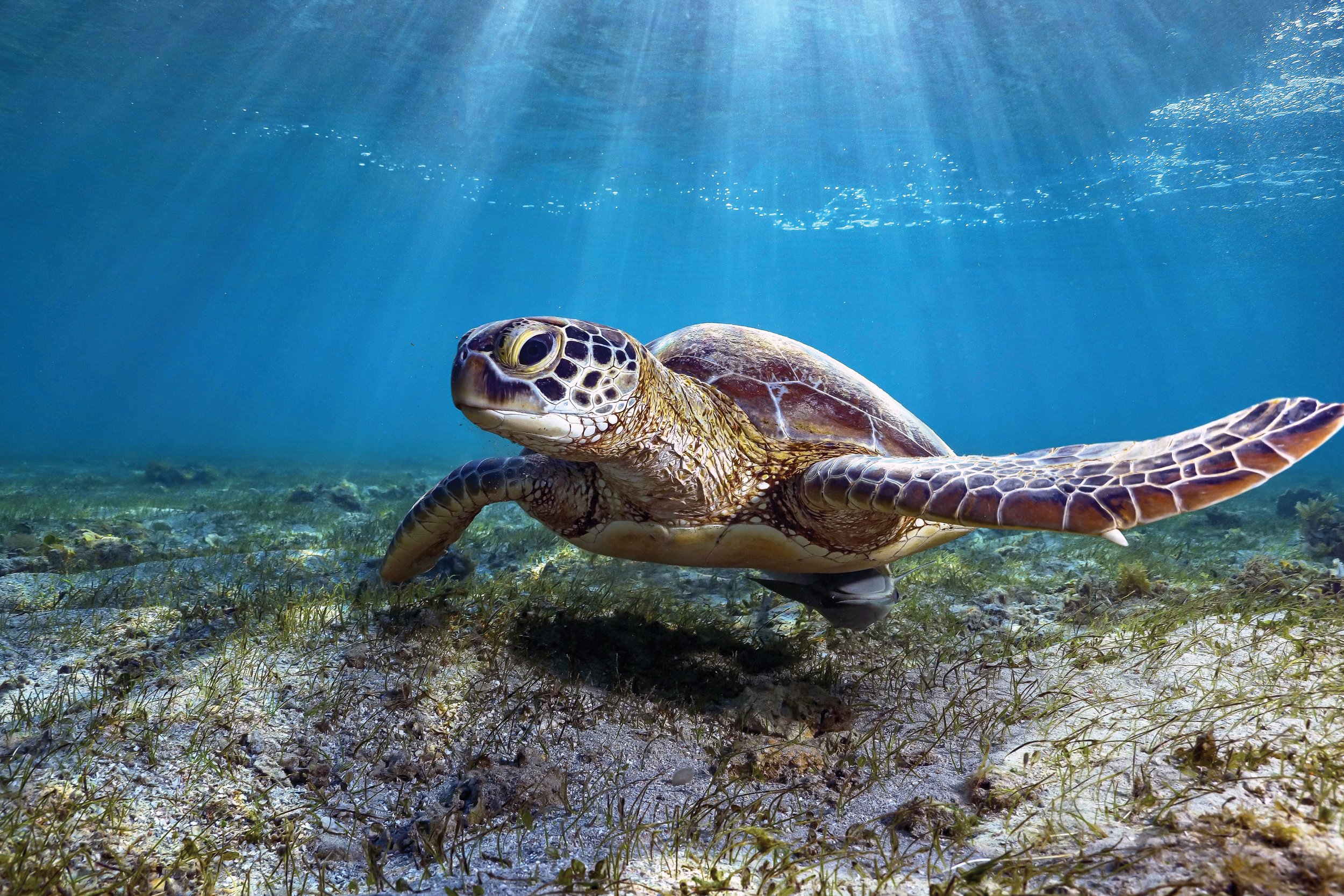The Rise and Fall of Green Turtles and Seagrasses in Bermuda
By Richard Herren, Daniel Evans, Gaëlle Roth, Jennifer Gray, David Godfrey, Anne Meylan, and Peter Meylan
A green turtle swims above seagrass, its primary food, with a remora in tow. © Serge Melesan
Bermuda is an ideal place to study immature green turtles and their foraging habitats. The island chain sits isolated a little more than 1,000 kilometers (620 miles) off the U.S. East Coast. There is no competition from nesting adults, because they were extirpated there by the late 1700s, and there are very few large oceanic predators. Seagrass beds on shallow offshore flats and nearshore bays are protected from open ocean swells by large reefs. The warm, clear water at the edges of the Gulf Stream and Sargasso Sea invites many subtropical species to this relatively northern location. And for a young oceanic green turtle in search of developmental habitat, Bermuda must seem an oasis of opportunity. However, this perceived green turtle paradise is no longer what it used to be.
Through its half-century-long capture-mark-recapture program, the Bermuda Turtle Project (BTP) has documented some troubling changes for the archipelago’s green turtles. Protections put in place in foraging grounds like Bermuda and in nesting beaches throughout the wider Caribbean have significantly increased the size of the Bermuda green turtle aggregation in recent decades. However, although green turtle densities increased in Bermuda from 1992 to 2018, larger turtles became much less common, body condition decreased, and site fidelity declined. Then, in 2020, the green turtle aggregation in Bermuda suddenly crashed, and today it is estimated to be about one-fourth of what it was just a few years ago. So what happened? It may be a simple case of green turtles eating themselves out of house and home, but research by the BTP over the past five decades suggests that the explanation is much more complicated.
Seagrasses are in trouble worldwide because of everything from higher land-based nutrient inputs to increased levels of boat propeller damage, and in Bermuda, seagrasses have been in decline since at least the late 1990s. By 2010, the decline had accelerated, and seagrasses (primarily turtlegrass, Thalassia testudinum, preferred by green turtles) had all but disappeared from offshore flats and had become sparse in nearshore bays. Today, the remaining pastures exist in sheltered inshore bays and are largely composed of manatee and shoal grasses (Syringodium filiforme and Halodule wrightii, respectively).
After millions of years of coexistence between green turtles and seagrasses, it is reasonable to expect that there are natural mechanisms in place that create balance between the grazers (turtles) and their primary food source (seagrasses). Indeed, the BTP’s data suggest that the green turtles in Bermuda were responding to the seagrass decline long before it was detected by biologists. Nevertheless, some researchers have sought to explain the loss of seagrass as entirely caused by green turtle overgrazing. That simple top-down (predator-driven) explanation seems unlikely, because it ignores both the existence of natural mechanisms to balance predator and prey and the high likelihood of other impacts on Bermuda’s seagrasses. In Australia, where seagrasses have also declined in areas with abundant green turtle populations, seagrass researchers have suggested that “synergistic stressors” from multiple threats are a more likely culprit for the declines. But what additional stressors might be at play in Bermuda?
Bermuda’s marine environment is subject to multiple human impacts. The roughly 54 square kilometers of land (21 square miles) are home to one of the highest human population densities on earth (1,200 people per square kilometer). An estimated 44,000 vehicles travel the narrow roads adjacent to the ocean, and another 7,600 boats are anchored in small bays or narrow passages. Bermuda does not have a centralized sewerage system. Homes and businesses rely instead on a mixture of septic tanks built into the porous limestone rock, deep-sealed boreholes for larger discharges, and offshore sewage pipes. Domestic and commercial garbage has been incinerated since 1996, and the ash is incorporated into cement-infused blocks that have been used as a shoreline stabilization material. Consequently, Bermuda has high concentrations of anthropogenic contaminants and nutrient loads in its water.
Resolution of this crisis for Bermuda’s green turtles will require a more comprehensive approach to understanding—and eventually reestablishing—Bermuda’s marine ecosystems. We need to move past the green turtle overgrazing hypothesis as the primary reason for the collapse of the island’s seagrass beds and closely examine the many other impacts that may be tipping the ecological balance. We recommend developing a multidisciplinary framework to identify all seagrass impacts, funding projects to study them, and then pursuing solutions to mitigate and minimize them. These problems are happening in other parts of the world as well, and what Bermuda’s government officials, scientists, and conservation leaders do next could serve as a model to help other nations to manage their seagrass and coral reef habitats and, indeed, to manage the fate of all marine species.
Author Affiliations
David Godfrey, Sea Turtle Conservancy, Florida, U.S.A.
Anne Meylan, Florida Fish & Wildlife Conservation Commission, Fish & Wildlife Research Institute, Florida, U.S.A.
Peter Meylan, Eckerd College, Florida, U.S.A.
Richard Herren, Sea Turtle Conservancy, Florida, U.S.A.
Daniel Evans, Sea Turtle Conservancy, Florida, U.S.A.
Gaëlle Roth, Bermuda Zoological Society, Flatts, Bermuda
Jennifer Gray, Bermuda Zoological Society, Flatts, Bermuda
This article originally appeared in SWOT Report, vol. 19 (2024). Click here to download the entire article as a PDF.

